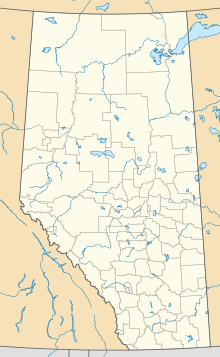Acadia Valley
Acadia Valley | |
|---|---|
 | |
| Coordinates: 51°09′25″N 110°12′35″W / 51.1569°N 110.2097°W | |
| Country | Canada |
| Province | Alberta |
| Planning region | Red Deer |
| Municipal district | M.D. of Acadia No. 34 |
| Government | |
| • Type | Unincorporated |
| • Governing body | M.D. of Acadia No. 34 Council |
| Area (2021)[1] | |
| • Land | 0.46 km2 (0.18 sq mi) |
| Elevation | 716 m (2,349 ft) |
| Population (2021)[1] | |
| • Total | 143 |
| • Density | 308.1/km2 (798/sq mi) |
| Time zone | UTC−7 (MST) |
| • Summer (DST) | UTC−6 (MDT) |
Acadia Valley is a hamlet in southeast Alberta, Canada within the Municipal District (MD) of Acadia No. 34.[3] The MD of Acadia No. 34's municipal office is located in Acadia Valley.
Acadia Valley is located along Highway 41 commonly referred to as Buffalo Trail between Oyen and Medicine Hat and sits about 14.5 km (9.0 mi) west of the Alberta-Saskatchewan border. Acadia Valley sits at an elevation of 716 m (2,349 ft).
The hamlet is located within census division No. 4. It was named in 1910 by settlers from Nova Scotia.[4]
Demographics
[edit]| Year | Pop. | ±% |
|---|---|---|
| 1941 | 86 | — |
| 1951 | 155 | +80.2% |
| 1956 | 249 | +60.6% |
| 1961 | 239 | −4.0% |
| 1966 | 222 | −7.1% |
| 1971 | 166 | −25.2% |
| 1976 | 136 | −18.1% |
| 1981 | 125 | −8.1% |
| 1986 | 132 | +5.6% |
| 1991 | 118 | −10.6% |
| 1996 | 138 | +16.9% |
| 2001 | 122 | −11.6% |
| 2006 | 140 | +14.8% |
| 2011 | 137 | −2.1% |
| 2016 | 149 | +8.8% |
| 2021 | 143 | −4.0% |
| Source: Statistics Canada [5][6][7][8][9][10][11][12][13][14][15][16][17][18][1] | ||
In the 2021 Census of Population conducted by Statistics Canada, Acadia Valley had a population of 143 living in 71 of its 86 total private dwellings, a change of -4% from its 2016 population of 149. With a land area of 0.46 km2 (0.18 sq mi), it had a population density of 310.9/km2 (805.1/sq mi) in 2021.[1]
As a designated place in the 2016 Census of Population conducted by Statistics Canada, Acadia Valley had a population of 149 living in 71 of its 82 total private dwellings, a change of 8.8% from its 2011 population of 137. With a land area of 0.47 km2 (0.18 sq mi), it had a population density of 317.0/km2 (821.1/sq mi) in 2016.[18]
Attractions
[edit]- Prairie Elevator Museum[19]
- Acadia Municipal Recreation Dam - trout fishing
See also
[edit]References
[edit]- ^ a b c d "Population and dwelling counts: Canada and designated places". Statistics Canada. February 9, 2022. Retrieved February 10, 2022.
- ^ "Alberta Private Sewage Systems 2009 Standard of Practice Handbook: Appendix A.3 Alberta Design Data (A.3.A. Alberta Climate Design Data by Town)" (PDF) (PDF). Safety Codes Council. January 2012. pp. 212–215 (PDF pages 226–229). Archived from the original (PDF) on October 16, 2013. Retrieved October 8, 2013.
- ^ "Specialized and Rural Municipalities and Their Communities" (PDF). Alberta Municipal Affairs. June 3, 2024. Retrieved June 14, 2024.
- ^ Hamilton, William (1978). The Macmillan Book of Canadian Place Names. Toronto: Macmillan. p. 20. ISBN 0-7715-9754-1.
- ^ Ninth Census of Canada, 1951 (PDF). Vol. SP-7 (Population: Unincorporated villages and hamlets). Dominion Bureau of Statistics. March 31, 1954. Retrieved September 19, 2024.
- ^ Census of Canada, 1956 (PDF). Vol. Population of unincorporated villages and settlements. Dominion Bureau of Statistics. October 25, 1957. Retrieved September 19, 2024.
- ^ 1961 Census of Canada: Population (PDF). Series SP: Unincorporated Villages. Vol. Bulletin SP—4. Ottawa: Dominion Bureau of Statistics. April 18, 1963. Retrieved September 19, 2024.
- ^ Census of Canada 1966: Population (PDF). Special Bulletin: Unincorporated Places. Vol. Bulletin S–3. Ottawa: Dominion Bureau of Statistics. August 1968. Retrieved September 19, 2024.
- ^ 1971 Census of Canada: Population (PDF). Special Bulletin: Unincorporated Settlements. Vol. Bulletin SP—1. Ottawa: Statistics Canada. March 1973. Retrieved September 19, 2024.
- ^ "Geographical Identification and Population for Unincorporated Places of 25 persons and over, 1971 and 1976". 1976 Census of Canada (PDF). Supplementary Bulletins: Geographic and Demographic (Population of Unincorporated Places—Canada). Vol. Bulletin 8SG.1. Ottawa: Statistics Canada. May 1978. Retrieved September 19, 2024.
- ^ 1981 Census of Canada (PDF). Place name reference list. Vol. Western provinces and the Territories. Ottawa: Statistics Canada. May 1983. Retrieved September 19, 2024.
- ^ 1986 Census of Canada (PDF). Population. Vol. Unincorporated Places. Ottawa: Statistics Canada. July 1988. Retrieved September 19, 2024.
- ^ 91 Census (PDF). Population and Dwelling Counts. Vol. Unincorporated Places. Ottawa: Statistics Canada. June 1993. Retrieved September 19, 2024.
- ^ 96 Census (PDF). A National Overivew: Population and Dwelling Counts. Ottawa: Statistics Canada. April 1997. Retrieved September 19, 2024.
- ^ "Population and Dwelling Counts, for Canada, Provinces and Territories, and Census Divisions, 2001 and 1996 Censuses - 100% Data (Alberta)". Statistics Canada. August 15, 2012. Retrieved September 19, 2024.
- ^ "Population and dwelling counts, for Canada, provinces and territories, and designated places, 2006 and 2001 censuses - 100% data (Alberta)". Statistics Canada. July 20, 2021. Retrieved September 19, 2024.
- ^ "Population and dwelling counts, for Canada, provinces and territories, and designated places, 2011 and 2006 censuses (Alberta)". Statistics Canada. February 8, 2012. Retrieved September 19, 2024.
- ^ a b "Population and dwelling counts, for Canada, provinces and territories, and designated places, 2016 and 2011 censuses – 100% data (Alberta)". Statistics Canada. February 8, 2017. Retrieved February 13, 2017.
- ^ M.D. of Acadia No. 34 - Points of Interest
External links
[edit]- Hamlet of Acadia Valley from the M.D. of Acadia No. 34 official web site


